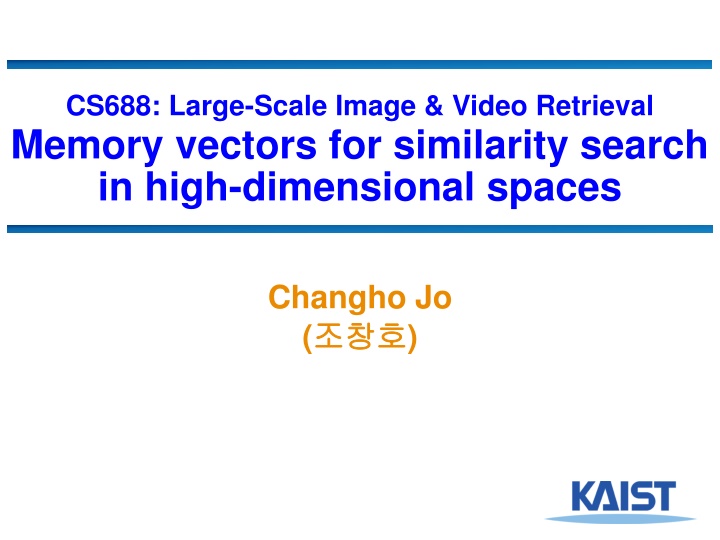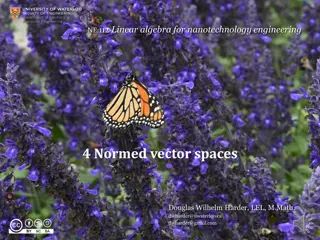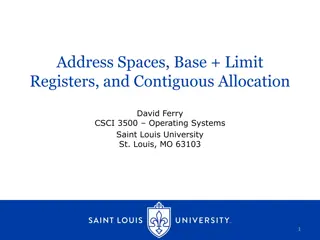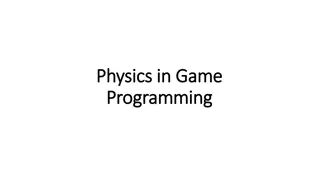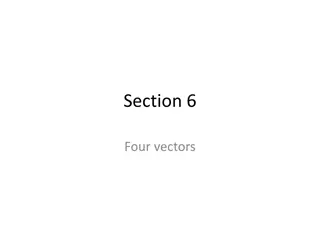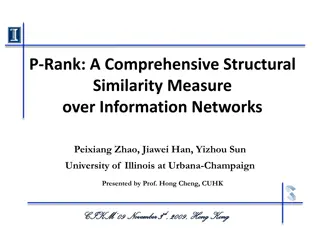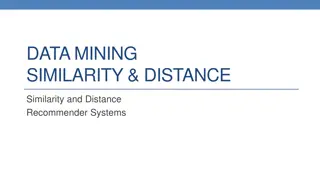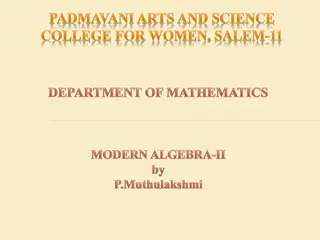Memory Vectors for Similarity Search in High-Dimensional Spaces
This content discusses the concept of memory vectors for improving similarity search in high-dimensional spaces using spread-out local feature descriptors. It delves into the comparison of spread-out pseudo-inverse vectors with traditional methods, highlighting their intrinsic similarities and the implications for image search applications. The importance of using representative vectors for efficient comparison and previous works on dimension reduction and aggregate local features are also explored.
Download Presentation

Please find below an Image/Link to download the presentation.
The content on the website is provided AS IS for your information and personal use only. It may not be sold, licensed, or shared on other websites without obtaining consent from the author.If you encounter any issues during the download, it is possible that the publisher has removed the file from their server.
You are allowed to download the files provided on this website for personal or commercial use, subject to the condition that they are used lawfully. All files are the property of their respective owners.
The content on the website is provided AS IS for your information and personal use only. It may not be sold, licensed, or shared on other websites without obtaining consent from the author.
E N D
Presentation Transcript
CS688: Large-Scale Image & Video Retrieval Memory vectors for similarity search in high-dimensional spaces Changho Jo ( )
Object of todays talk Actually, I was going to present the paper Learning Spread-out Local Feature Descriptors (ICCV 2017, X. Zhang) It learns to spread out all the points in the descriptor space so that the network fully utilize the descriptor space(searching will be more easier) 2
Object of todays talk But I found that concept of pinv is actually same as the spread-out Pseudo-inverse & Spreading-out ||m|| = 1 3
Object of todays talk And their analysis are exactly same. So the message of two papers are intrinsically same. 4
Object of todays talk My object here is Explaining why they introduced pseudo inverse vector(in image search) Confirming with results And not Algebra like this 5
Recall When they[1] aggregates each vector of perspective images They used Sum vector descriptor([x1, x2, ..., xn]): SIFT+NetVlad Pinv vector 6
Recall Why they used it? Fewer comparison (=less runtime) 24 queries 1 query We also use the representative vectors in DB side. So we only compare 24*24 less vectors. 7
Previous works 1. Dimension reduction of each features image descriptors -> bits (or smaller descriptors) Spherical hashing, product quantization, inverted multi index 8 https://sgvr.kaist.ac.kr/~sungeui/IR/Slides/Lec6-Hashing.pdf
Previous works 2. Aggregate local features VLAD(Vector of locally aggregated descriptors), BOW, FV 9 https://sgvr.kaist.ac.kr/~sungeui/IR/Slides/Lec6-Hashing.pdf
Previous works 2. Aggregate local features VLAD(Vector of locally aggregated descriptors), BOW, FV Authors arguing that pinv is different because 1. Not local features -> global, global feature -> group 2. No semantic meanings like them 3. Keep the same descriptor dimension(Not something like d: 1024-> 256) 10
Before the journey KEY IDEA: You should remember that purpose of pinv is same as making the variance bigger. here the variance means variance of descriptors 11 Learning Spread-out Local Feature Descriptors, ICCV 2017, X. Zhang
Before the journey You should not that descriptors are already calculated Ex) we can think red stars as M1, yellow stars as M2, and so on... 12 Learning Spread-out Local Feature Descriptors, ICCV 2017, X. Zhang
Before the journey I will start from sum vector, because it gives motivation to apply pseudo-inverse Before we move on, we need some definitions 13
Problem formulation We have memory unit X={x1, x2, ..., xn} xi = d dimensional vector We also have query vector y ||xi|| = 1, ||y|| = 1 vectors xi are IID samples from a uniform distribution on the d-dimensional unit hypersphere. How many comparison needed for naive approach? 14 Learning Spread-out Local Feature Descriptors, ICCV 2017, X. Zhang
Problem formulation We measure similarity by inner product xiTy And we want to find one xiwhich is most similar to y for human, but it is ambiguous So instead, we find all xi which satisfy xiTy ?0 query Can u guess ?0 on this (hyper)sphere? ?0 15 Learning Spread-out Local Feature Descriptors, ICCV 2017, X. Zhang
IDEA For a sum memory vector Now we will solveVariation of mTy ?0 ?0is just a parameter; let s ignore it as now You are ready to solve, but I ll show only hypothesis because the algebra takes lots of time 16
Variation of descriptors Hypothesis0: Y is not related to any vector in X(uniformly distributed) TL;DR: (variation) = Hypothesis1: Y is related to one vector in X(Y = x1 + Z, Z is a random vector orthogonal to x1 and ||z||=1) TL;DR: (variation) = 17
Variation of descriptors (variation) = or You should note that we cannot control d(we cannot control curse of dimension) But you can control ||m||, So the answer is ||m|| = 0? Then memory vectors are destroyed.. 18
Variation of descriptors (variation) = or Constraints where 1n is the length-n vector with all entries equal to 1 1. It gives minimum ||m|| 2. It gives direction of m(average of X or X ) 19
Variation of descriptors minimizing s.t. The solution is pseudo-inverse! sol Since we are only considering high d And it becomes minimizer of if no solution exists => linear regression problem! 20
Variation of descriptors Also you can see the 0 as last constraint. In other words, we find calculated memory vectors which is enough( 0) close to the query vector. small 0 => need to compare lots of memory vectors query too large 0=> there s no memory vector to compare ?0 21 Learning Spread-out Local Feature Descriptors, ICCV 2017, X. Zhang
Variation of descriptors Explaining why they introduced pseudo inverse vector It maximize variation while we have some constraints, so that we can spread out the memory vectors Confirming with results 22
Results Experiment setting Dataset: Inria Holidays, Oxford5k, UKB, Holidays+Flickr1M, Yahoo100M Descriptor: triangular embedding descriptor[1](I don t know either in detail, SOTA at 2017), VLAD descriptor d=8064 for triangular embedding, d=1024 for VLAD Another details need again algebra. [1]H. Jegou and A. Zisserman, Triangulation embedding and democratic kernels for image search, in CVPR, June 2014. 23
Results In case the dataset have label: used it Otherwise Random assignment: they grouped N vectors to M units of n vectors randomly Ex) red stars: n=3, total M=6, total N=14 24 Learning Spread-out Local Feature Descriptors, ICCV 2017, X. Zhang
Results Random assignment: they grouped N vectors to M units of n vectors randomly vertical axis: cost(memory) / cost(naive) horizontal axis: n Red: sum, Blue: pinv darker color: higher 0(0.5, 0.6, ..., 0.9) 25
Results ROC curves Test performs better when 0 is closer to 1 Do you understand what two results mean? 26
Summary Explaining why they introduced pseudo inverse vector It maximize variation while we have some constraints, so that we can spread out the memory vectors Confirming with results Num of Comparison Higher 0 => less comparison Pinv needs less comparison then Sum because the property of spreading-out 27
Summary Contribution Very algebraic approach of the paper Learning Spread-out Local Feature Descriptors (ICCV 2017, X. Zhang) 28
Quiz What is the maximum angle between memory vector(m) and descriptor vectors(X)? query 1. arccos( 0) 2. No limit 3. 90 ?0 29 Learning Spread-out Local Feature Descriptors, ICCV 2017, X. Zhang
Quiz Let s say we did random assignment. Random assignment: they grouped N vectors to M units of n vectors randomly We have M =10 n = 5 (percentage that one of the memory vectors found by query) = 60% How many comparison needed by 1 query? 1. 40 2. 10 5. No answer in above candidates. query ?0 3. 13 4. 26 30 Learning Spread-out Local Feature Descriptors, ICCV 2017, X. Zhang
